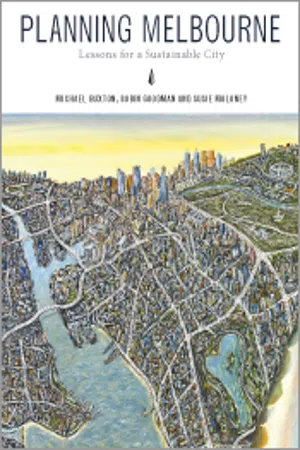Green Belt
A Green Belt refers to an area of open land, often surrounding urban areas, that is protected from development to prevent urban sprawl and promote environmental conservation. These areas typically contain parks, forests, and agricultural land, providing a buffer between urban and rural areas. Green Belts help to maintain biodiversity, provide recreational space, and improve air quality within urban regions.
3 Key excerpts on "Green Belt"
- eBook - ePub
- Michael Hough(Author)
- 2004(Publication Date)
- Routledge(Publisher)
...In practice this means that urban growth needs to be denser and more compact, focusing on small neighbourhoods, and combining homes with jobs and services. 8 Greenbelts have a number of purposes: to protect watersheds, groundwater, aquifers and other biophysical components of the landscape; protect the countryside and farmland from urban encroachment; prevent neighbouring towns from merging together; preserving the physical setting and special character of historic towns; and assisting in urban regeneration by encouraging the reuse of derelict urban land. Boundaries also need to be clearly defined to ensure the long-term viability of agriculture, recreation and amenity, by using physical features such as roads, streams or woodland edges. Figure 7.2 The current fourteen greenbelts in the UK totalling 1,555,700 hectares. The government policies for the countryside are set out in the White Paper Rural England; A Nation Committed to a Living Countryside, 9 requiring that the countryside be managed sustainably. This entails accommodating necessary change to rural areas, encouraging economic diversity and employment, reducing travel by car, maintaining the character of the countryside and the quality of rural towns and villages – in effect, safeguarding distinctive landscapes. It is at the local county level, however, that policies and principles are implemented, and that local needs and issues and the peculiar environmental and political conditions of local districts come face to face with national greenbelt policies. This was borne out in 1996 hearings in which representations were made to a panel that was conducting a public examination of the County of Dorset Structure Plan (to the year 2011). With regard to the issue of settlement patterns, a question under debate was whether the boundaries of the south-east Dorset greenbelt should be adjusted to allow for additional development...
- eBook - ePub
- Marco Amati, Marco Amati(Authors)
- 2016(Publication Date)
- Routledge(Publisher)
...CHAPTER 1 Green Belts: A Twentieth-century Planning Experiment Marco Amati The general public creates an outcry if any attempt is made to invade this Green Belt and that is something we want to get into planning – the creation of public interest. We want to get them to know something of our work and support us in our activities (Abercrombie, 1948, 13) The implementation of Green Belts in many countries can be regarded as one of the most internationally famous attempts to control urban growth. Green Belts have ringed major cities to prevent them sprawling. Planners have used them to separate satellite ‘new towns’ from the urban core, safeguarding land for recreation, agriculture and forestry. Green Belts have also provided sites for more utilitarian uses such as salvage yards, incinerators and quarries. In some places, areas of the Green Belt have suffered through illegal dumping or through neglect. The popularity of Green Belts among planners during the twentieth century is due to the alignment of their attributes with some of the assumptions that underpinned modernist planning. These assumptions were that strict divisions between different land-uses could be unproblematically drawn, and that planners’ actions could be justified by normative conventions and a search for universal truths. As planners began to grapple with the messy realities of urban growth during the twentieth century, Green Belts gave them a tool to realise a normative geography that a city has natural limits, that urban and rural areas should be separated and that settlements should be balanced and evenly-spaced. Green Belts were used as part of a project to construct a universal planning canon, being employed regardless of the contingencies that affect urban growth in different cities around the world...
- eBook - ePub
Planning Melbourne
Lessons for a Sustainable City
- Michael Buxton, Robin Goodman, Susie Moloney(Authors)
- 2016(Publication Date)
- CSIRO PUBLISHING(Publisher)
...Chapter 7 Protecting Melbourne’s Green Belt and peri-urban area Peri-urban areas Peripheral urban (peri-urban) areas on the edges of urban centres, are the regions into which cities expand (Burnley and Murphy 1995) or which cities influence (Houston 2005). All Melbourne’s outward suburban growth therefore takes place in peri-urban areas. The Green Belt, which includes green wedges between corridors of growth established in the 1971 plan, was an early recognition of the values of Melbourne’s inner peri-urban region. Suburban dwellers would have easy access to non-urban land with a range of recreation and health benefits. Large regional parks would be established in the Green Belt, and environmental and agricultural values protected. Areas of high significance including the Dandenong Ranges, Yarra Valley and Mornington Peninsula would be maintained. This work anticipated the later recognition of the benefits to human health and culture from urban Green Belts that protected rural landscapes, recreational opportunities and a wide range of food-producing activities (Giles-Corti et al. 2012). Melbourne’s peri-urban region consists of two belts of non-urban landscapes and towns around the city (see Fig. 7.1). The first or inner belt extends from the metropolitan urban growth boundary to the outer rural boundary of the 17 municipalities which form the Melbourne Green Belt, encompassing over 8829 km 2. This inner area includes such environmentally significant landscapes as the Mornington Peninsula, the Dandenong Ranges and the Yarra Valley. The outer belt includes eight municipalities and other regional cities and townships, covering over 15 000 km 2 and extending over a range of landscapes from mountain forests, woodlands and lowland forests, cleared farming land and coastal areas...


